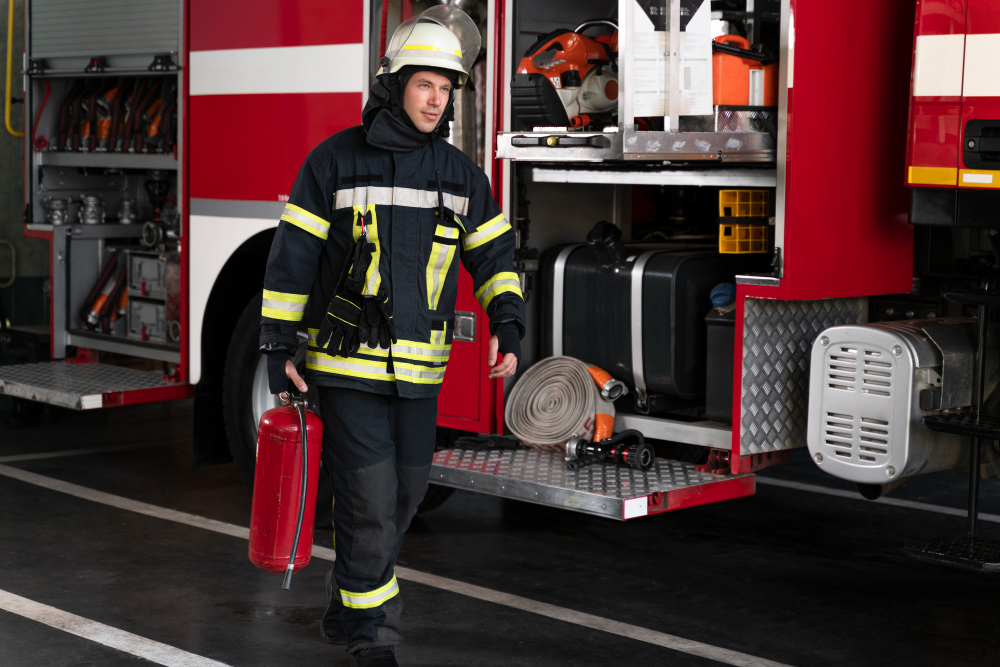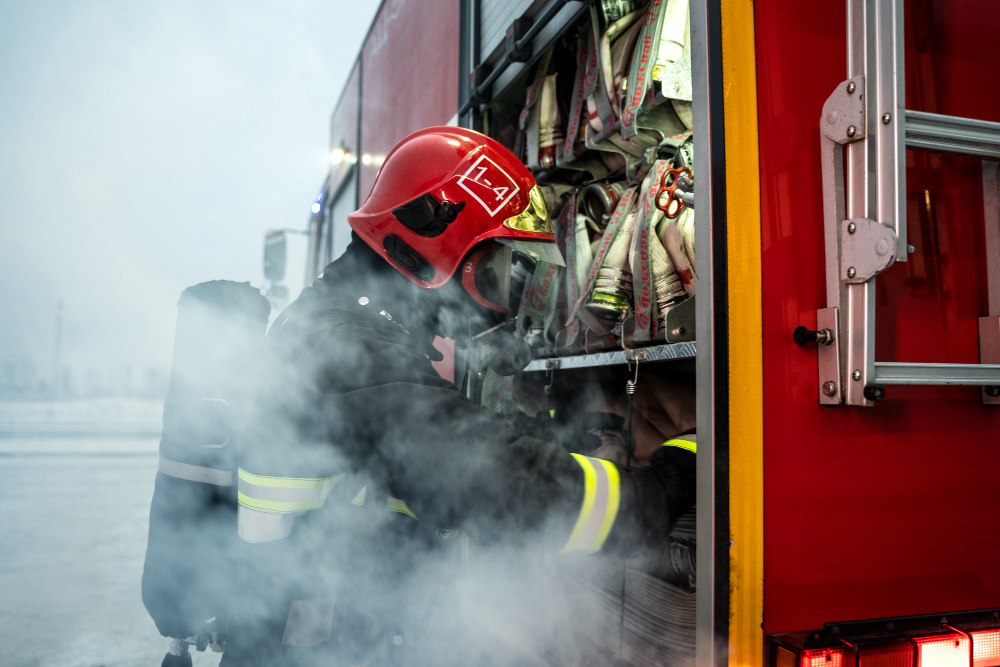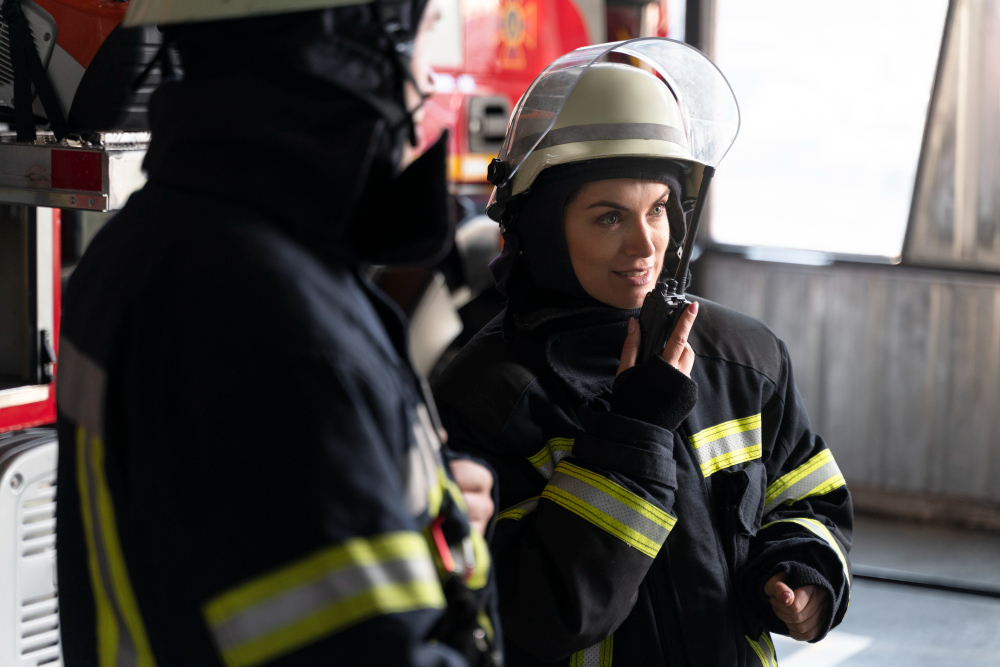6 Week Firefighter Workout Program: From Rookie to Rescue Ready

When the alarm sounds, firefighters spring into action, carrying up to 75 pounds of gear while racing against time and flames. These modern-day heroes need more than just courage—they need exceptional physical fitness that combines strength, endurance, agility, and mental toughness. The firefighter workout isn’t just another fitness routine; it’s preparation for saving lives, including their own.
Table of Contents
As a former firefighter turned fitness coach, I’ve seen firsthand how proper training can make the difference between success and failure in the field. Whether you’re an aspiring firefighter preparing for the physical abilities test, a seasoned veteran looking to stay fit for duty, or someone who wants a challenging functional fitness program, this comprehensive firefighter workout guide will help you build the body and mindset needed to thrive under pressure.
Why Firefighter Fitness Is Different

The demands placed on firefighters’ bodies are unlike almost any other profession. In a single shift, they might go from complete rest to maximum exertion in seconds, then sustain that effort for hours.
“Most people don’t realize that firefighting is essentially an extreme sport with lives on the line,” says Captain Mike Salerno, a 15-year veteran firefighter and departmental fitness coordinator. “We need to train accordingly.”
A proper firefighter workout program addresses several specific physical demands:
- Cardiovascular endurance for sustained operations while wearing heavy equipment
- Functional strength for forcible entry, victim carries, and equipment handling
- Core stability for injury prevention when working in awkward positions
- Grip strength for tool manipulation and climbing
- Anaerobic power for sudden bursts of intense activity
- Heat tolerance and recovery capabilities between tasks
The workout routine I’m sharing has been refined through years of experience training firefighters and is designed to develop all these qualities while being adaptable to different fitness levels.
The Core Components of an Effective Firefighter Workout
Before diving into the specific exercises, let’s understand the framework that makes a firefighter workout both functional and effective:
1. Functional Movement Patterns
Firefighters don’t do isolated bicep curls on the job. Their movements involve multiple muscle groups working together to accomplish specific tasks. Your firefighter workout should emphasize these seven fundamental movement patterns:
- Push (advancing hose lines, forcing doors)
- Pull (dragging victims, hoisting equipment)
- Hinge (picking up tools, lifting objects)
- Squat (lifting from ground level)
- Carry (moving equipment and victims)
- Rotate/Anti-rotate (controlling hose lines, stabilizing against uneven forces)
- Climb/Crawl (navigating structures)
2. Work-to-Rest Ratios That Mimic the Job
Fire scenes aren’t predictable—they involve intense bursts of activity followed by briefer recovery periods. Your firefighter workout should incorporate interval training that simulates these demands.
3. Progressive Overload with Job Specificity
As with any training program, progression is key. But for firefighters, this means not just adding weight but also increasing complexity, reducing rest times, or adding job-specific challenges like working with limited visibility or in confined spaces.
The Ultimate Firefighter Workout Program
This comprehensive firefighter workout program is divided into four training days, with flexibility for active recovery days. Each workout begins with a dynamic warm-up and ends with targeted mobility work.
Workout 1: Strength and Power Focus
Warm-up: 5-minute cardio + dynamic stretching sequence
Circuit 1: Perform 4 rounds with minimal rest between exercises, 60-90 seconds between rounds
- Weighted Vest Squats: 12 reps (simulate gear weight)
- Pull-ups or Assisted Pull-ups: 8-12 reps
- Farmers Carry: 40 yards with heavy dumbbells
- Push Press: 10 reps with challenging weight
- Plank with Shoulder Tap: 30 seconds
Circuit 2: Perform 3 rounds
- Deadlift: 8 reps with heavy weight
- Sled Push/Pull: 40 yards each direction
- Renegade Rows: 10 reps each arm
- Battle Rope Waves: 30 seconds work, 30 seconds rest
Finisher:
- Stair Climb with Weight Vest: 5 minutes at challenging pace
Cool-down: 5-10 minutes of targeted mobility work
Workout 2: Endurance and Work Capacity
Warm-up: 5-minute cardio + dynamic stretching sequence
EMOM (Every Minute On the Minute): 20 minutes
- Minute 1: 10 burpees
- Minute 2: 15 kettlebell swings
- Minute 3: 20 mountain climbers (each leg)
- Minute 4: 10 push-ups
- Minute 5: 30-second plank hold
Hose Line Advance Simulation: 4 rounds
- Battling ropes in kneeling position: 30 seconds
- Bear crawl 20 yards
- Backward drag of weighted sled: 20 yards
- 10 medicine ball slams
Finisher:
- Tabata intervals (20 seconds work/10 seconds rest) of bodyweight squats, push-ups, and mountain climbers: 4 rounds each
Cool-down: 5-10 minutes of targeted mobility work
Workout 3: Job-Specific Tasks and Skills
Warm-up: 5-minute cardio + dynamic stretching sequence
Stair Master Challenge: 10 minutes with weight vest at moderate pace
Firefighter Task Circuit: 3 rounds
- Sledgehammer strikes on tire: 20 reps
- Hose drag with charged line or equivalent weight: 50 feet
- Dummy drag or heavy bag drag: 50 feet
- Forcible entry simulation (sledgehammer horizontal strikes or battling rope): 30 seconds
- Ceiling breach and pull simulation (overhead press + pull-down): 10 reps
Equipment Carry Medley: Complete once
- Carry two kettlebells overhead: 40 yards
- Carry one heavy dumbbell in each hand: 40 yards
- Carry one heavy dumbbell on shoulder: 40 yards each side
- Fireman’s carry with training partner or dummy: 40 yards
Cool-down: 5-10 minutes of targeted mobility work
Workout 4: HIIT and Recovery
Warm-up: 5-minute cardio + dynamic stretching sequence
AMRAP (As Many Rounds As Possible): 20 minutes
- Row 250 meters
- 10 dumbbell thrusters
- 10 TRX rows
- 10 box jumps or step-ups
Core Circuit: 3 rounds
- Weighted sit-ups: 15 reps
- Side plank with rotation: 10 each side
- Medicine ball wood choppers: 10 each side
- Ab wheel rollouts: 10 reps
Recovery Work:
- Foam rolling: 10 minutes targeting major muscle groups
- Stretching: 10 minutes focusing on shoulders, hips, and back
Adapting Your Firefighter Workout for Different Needs
For Academy Preparation
If you’re preparing for the firefighter physical abilities test, focus extra attention on:
- Stair climbing with added weight
- Upper body pushing and pulling strength
- Grip endurance
- Sprint intervals while carrying weight
“When I was preparing for the academy, I would run stairs three times a week with gradually increasing weight,” shares Firefighter Sarah Chen. “By test day, the actual test felt easier than my training.”
For On-Duty Fitness
Working firefighters face unique challenges fitting in workouts between calls. Consider:
- Breaking workouts into shorter segments that can be completed between calls
- Quick-hit circuits that can be performed with minimal equipment
- Recovery-focused work during overnight shifts
- Team workouts that build camaraderie while improving fitness
For Injury Prevention and Longevity
Veteran firefighters know that career longevity depends on smart training:
- Emphasize proper form over heavy weight
- Incorporate regular mobility work for shoulders, hips, and back
- Focus on core strength and stability
- Include adequate recovery between intense training sessions
Nutrition to Fuel the Firefighter Workout
No firefighter workout program is complete without addressing nutrition. The physical demands of firefighting require proper fueling strategies:
- Hydration: Aim for at least half your body weight in ounces of water daily, more on workout days and during shifts
- Protein: Consume 0.7-1g per pound of body weight to support muscle recovery and maintenance
- Meal Timing: Plan meals around shift schedules and workouts
- Practical Meal Prep: Prepare shift-friendly meals that can be eaten quickly or reheated
“The firehouse kitchen can be your biggest ally or worst enemy for fitness,” notes Firefighter/Paramedic and Nutrition Coach Tom Willis. “Having prep-ahead healthy meals ready can save you from the 3 AM pizza order.”
Mental Toughness: The Often Overlooked Component
The most effective firefighter workout doesn’t just build physical strength—it builds mental resilience. Here’s how to develop the psychological edge needed for the job:
- Imposed Stress Training: Occasionally train with artificial stressors like time constraints or added complications
- Visualization: Practice mentally working through challenging scenarios
- Breath Control: Incorporate tactical breathing techniques into high-intensity portions of your workout
- Team Challenges: Partner with fellow firefighters for accountability and shared challenge
“The physical challenges are tough, but it’s the mental fortitude that separates good firefighters from great ones,” says Battalion Chief Lauren Rodriguez. “Your firefighter workout should push you past your comfort zone regularly.”
Putting It All Together: Your Customized Firefighter Workout Plan
The most effective firefighter workout program is one you’ll actually follow consistently. Here’s how to make this program work for you:
- Assess your current fitness level honestly. Begin with modifications if needed.
- Identify your specific goals: academy prep, on-duty fitness, or overall functional strength.
- Schedule your workouts realistically around shifts and recovery needs.
- Track progress not just in weight lifted but in work capacity and recovery time.
- Adjust as needed based on job demands, injuries, or schedule changes.
Remember that consistency trumps intensity. A moderate firefighter workout performed regularly will yield better results than sporadic all-out efforts followed by weeks of inactivity.
The Firefighter’s Edge: Beyond Physical Training
While this firefighter workout program will build the physical capabilities needed for the job, the most successful firefighters combine this with:
- Technical skill development: Regularly practice job-specific skills
- Tactical knowledge: Study building construction, fire behavior, and strategy
- Team coordination: Work on communication and coordination drills
- Recovery practices: Emphasize sleep quality, stress management, and active recovery
“The fittest firefighter isn’t necessarily the strongest or fastest,” reflects 25-year veteran Captain James Washington. “It’s the one who can perform at a high level when it matters most, time after time, without breaking down.”
Conclusion: Building Fitness That Saves Lives

The ultimate firefighter workout isn’t about looking good in uniform—though that might happen too. It’s about developing functional fitness that serves a higher purpose: protecting communities and saving lives.
Whether you’re just starting your journey toward becoming a firefighter or you’re a seasoned veteran looking to stay fit for duty, remember that each workout is an investment in your ability to perform when lives depend on it.
Begin incorporating these principles and exercises into your routine today. Start where you are, progress systematically, and focus on movements that transfer directly to the fireground. Your body—and potentially the people you’ll someday rescue—will thank you.
Ready to take your firefighter fitness to the next level? Share this article with your crew, try the workout program for six weeks, and let me know how it transforms your on-the-job performance. Stay safe, stay strong, and keep training with purpose.
